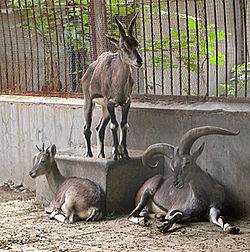- Bharal
-
Pseudois
Bharal
Pseudois

Grand bharal (Pseudois nayaur) Classification classique Règne Animalia Embranchement Chordata Classe Mammalia Infra-classe Eutheria Cohorte Laurasiatheria Ordre Cetartiodactyla Sous-ordre Ruminantia Famille Bovidae Sous-famille Caprinae Sous-tribu Caprina Genre Pseudois
Hodgson, 1846 Retrouvez ce taxon sur Wikispecies
Retrouvez ce taxon sur Wikispecies
D'autres documents multimédia
sont disponibles sur CommonsParcourez la zoologie sur Wikipédia : Le genre Pseudois regroupe deux espèces de caprins appelés bharals habitant les hautes montagnes d'Asie (Himalaya…).
Sommaire
Espèces et mensurations
Il existe deux espèces de bharals :
- Pseudois nayaur Hodgson, 1833 - Grand bharal ou Mouton bleu
- Taille : 115 à 165 cm
- Hauteur au garrot : 75 à 90 cm
- Poids : 55 à 73 kg
- Cornes : jusqu'à 80 cm
- Queue : 10 à 20 cm
- Pseudois schaeferi Haltenorth, 1963 - Petit bharal
- Taille : 100-110 cm
- Hauteur au garrot : ♀ 64 cm, ♂ 70 à 80 cm
- Poids : ♀ 25 kg, ♂ 28 à 44 kg
- Cornes : jusqu'à 41 cm
- Queue : env. 15 cm
Répartition
Les deux espèces habitent les hautes montagnes de l'Himalaya. Le grand bharal (Pseudois nayaur) vit au Bhutan, en Chine, en Inde, au Népal, au Pakistan, au Tadjikistan et au Tibet. Le petit bharal (Pseudois schaeferi), lui, n'habite qu'une seule région reculée de la Chine (haute gorge de Yangtze). Il vivent entre 1 000 et 5 500 mètres d'altitude. Les bharals sont néanmoins rares et sont vulnérables. Le petit bharal fait malheureusement partie de la liste rouge de l'IUCN.
Comportement
Le comportement des bharals est semblable à celui des bouquetins et des mouflons à manchettes. Ils sont herbivores. Les mâles vivent séparément, excepté pendant la période nuptiale ; les femelles vivent en groupes.
Références externes
- Référence Mammal Species of the World : Pseudois (en)
- Référence Tree of Life Web Project : Pseudois (en)
- Référence ITIS : Pseudois Hodgson, 1846 (fr) ( (en))
- Référence Animal Diversity Web : Pseudois (en)
- Référence NCBI : Pseudois (en)
- Portail de la zoologie
Catégories : Mammifère (nom scientifique) | Bovidé - Pseudois nayaur Hodgson, 1833 - Grand bharal ou Mouton bleu
Wikimedia Foundation. 2010.
